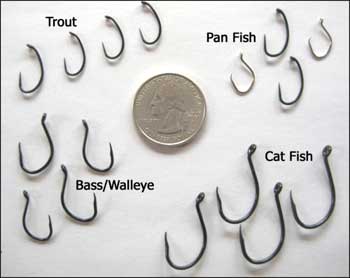
When you’re fishing with barbless hooks, chances are you will find it easier to hook fish. I always use barbless hooks when they suit the situation, and here is what is good about barbless fishing hooks. Using Barbless Fishing Hooksīarbless hooks come without barbs when you buy them or become barbless when you crimp the barb down. If you are fishing for saltwater fish or freshwater fish that you can remove and take home for eating purposes, then barbed hooks are the best option.īarbed hooks give a slightly better chance of landing the fish, and any damage caused to the fish is irrelevant since you will kill the fish anyway. So, this catch-and-release rule makes sense, as it will maintain fish health across the whole fishery population. This is particularly an issue for young or inexperienced anglers. In my opinion, most damage is caused when an angler tries to remove the hook from the mouth, and since the barb prevents this from being done easily, anglers tend to pull and be sometimes rough in trying to extract the hook. This can be a controversial opinion, and some anglers have written articles arguing that the barbless hook can create more damage as it can move around more in the fish’s mouth and is not “anchored.” The movement from side to side potentially increases the hold in the fish’s lip, causing some small mouth damage. Many lakes and ponds are catch-and-release fishing – where no barbed hooks are allowed.īarbed hooks are often banned as they cause more damage to fish than barbless hooks, and you’ll usually find this rule at catch-and-release fisheries. When you buy hooks, approximately 75% of the hooks available in shops will be barbed, and therefore you’ll be able to buy the exact hook you want for any purpose, but it will have a barb.īarbed hooks are available in more sizes and are generally slightly cheaper due to the manufacturing process for hooks being more widely used for barbed hooks. But, when fish run at you and create slack, or jump, shake their head and create slack, a barbed hook is far more likely to hold onto the fish than a barbless one. If you fight a fish and keep tension on it all the time, chances are no hook would ever come out. Once you have hooked a fish, a barbed hook is more likely to stay in the fish’s mouth than a barbless hook, but only if you lose tension on the fish. Without the barb, your live bait could fall off the hook before a bigger fish comes along and has a chance to eat it. If you’ve hooked a live bait in the back, the barb stops the hook from falling out of the fish as it swims around and tries to break free. You end up losing your bait more often and possibly catching fewer fish. When you’re bottom fishing with dead bait, fish will start pulling on the bait when they eat it, and without the barb, the bait can easily slip right off the hook after a few bites. When you are using, say, a chunk of squid for bottom fishing or have hooked a live minnow in the back in the hope of a predator coming along, a barbed hook will be very effective at holding on to the bait. They are also much better at holding squid or crab baits. Here are the good things about barbed fishing hooks Holding Dead Or Live Baitsĭead or Live baits are best used with barbed hooksīarbed hooks are designed, as I mentioned above, to hold on to natural baitfish such as herring, roach, or fish, whether dead or alive, particularly when predator fishing. Using Barbed Fishing Hooksīarbed fishing hooks have their place in the world of fishing and are probably the most popular hook used everywhere, and for good reasons, in most cases.

Since the barb faces the opposite way of the hook point, it stops the hook from being pulled in the opposite direction and keeps it in the fish’s mouth. The second purpose of a barb is to stop the hook from falling out of a fish’s mouth once it has gone in.


The first purpose is to hold your bait on the hook, especially when you’re fishing with dead bait or live bait, as the barb stops the hook from pulling out of the bait while it’s swimming or being pulled at by fish in the water. The barb on a fishing hook has two purposes. What Is The Purpose Of The Barb On A Hook? The barb faces the opposite direction to the hook point, which makes it useful in a fishing context – more on that coming up. What Is A Barb On A Barbed Hook For?Ĭhances are, you already know what a barb is, but if some of our readers don’t, let’s ensure we are all on a level playing field before moving forward.Ī hook barb is an extension protruding from the hook shank and sits below the point on the inside of the hook. A barbless hook has no “prong” the sharp point hooks into the lip, and by keeping tension on the line and is kept constant, then the fish cannot escape from the hook.


 0 kommentar(er)
0 kommentar(er)
